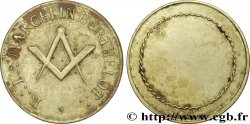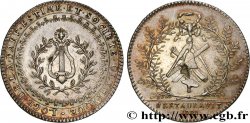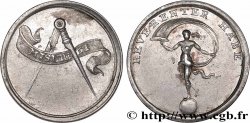fjt_235289 - FRANC-MAÇONNERIE - PARIS LOGE ÉCOSSAISE DE JERUSALEM 1817
Nicht verfügbar.
Artikel auf unserem Online-Shop verkauft (2010)
Preis : 65.00 €
Artikel auf unserem Online-Shop verkauft (2010)
Preis : 65.00 €
Type : LOGE ÉCOSSAISE DE JERUSALEM
Datum: 1817
Metall : Kupfer
Durchmesser : 30 mm
Stempelstellung : 12 h.
Rand lisse
Seltenheitsgrad : R1
N° im Nachschlagewerk :
Vorderseite
Titulatur der Vorderseite L.:. ÉCOSSAISE DE JERUSALEM / O.:. DE PARIS 5817.
Beschreibung Vorderseite Compas et équerre entrecroisés entourant une truelle rayonnante portant un G.
Rückseite
Titulatur der Rückseite POUR LES MAÇONS IL EST TOUJOURS FLEURI.
Beschreibung Rückseite Acacia en forme de palmier portant les lettres BJ et encadré par un triangle et un maillet.
Kommentare
La franc-maçonnerie s’implante en France aux alentours du premier quart du XVIIIe s. sous l’influence d’aristocrates anglais. Initiatique, elle est fondée sur le rite hiramique, du nom d’Hiram de Tyr, personnage biblique, architecte du roi Salomon sur le chantier du Temple et qui a résisté à la torture sans livrer ses secrets. Hiram a aussi donné un point de départ du calendrier maçonnique commençant 4000 ans avant le calendrier chrétien. Les symboles servent de signes de reconnaissance entre les initiés, notamment des outils de constructeur de cathédrales (équerre, compas, niveau, maillet, etc.), des formes (triangle, étoile), des nombres (trois, cinq, sept) et des lettres.
Freemasonry was established in France around the first quarter of the 18th century under the influence of English aristocrats. An initiatory practice, it is based on the Hiramic rite, named after Hiram of Tyre, a biblical figure, architect of King Solomon on the construction site of the Temple, who withstood torture without revealing his secrets. Hiram also provided a starting point for the Masonic calendar, which began 4,000 years before the Christian calendar. Symbols serve as signs of recognition between initiates, including cathedral builder's tools (set square, compass, level, mallet, etc.), shapes (triangle, star), numbers (three, five, seven), and letters.
Freemasonry was established in France around the first quarter of the 18th century under the influence of English aristocrats. An initiatory practice, it is based on the Hiramic rite, named after Hiram of Tyre, a biblical figure, architect of King Solomon on the construction site of the Temple, who withstood torture without revealing his secrets. Hiram also provided a starting point for the Masonic calendar, which began 4,000 years before the Christian calendar. Symbols serve as signs of recognition between initiates, including cathedral builder's tools (set square, compass, level, mallet, etc.), shapes (triangle, star), numbers (three, five, seven), and letters.








 Berichten über einen Fehler
Berichten über einen Fehler Die Seite drucken
Die Seite drucken Teilen meiner Auswahl
Teilen meiner Auswahl Stellen Sie eine Frage
Stellen Sie eine Frage Einlieferung/Verkauf
Einlieferung/Verkauf
 Details
Details











